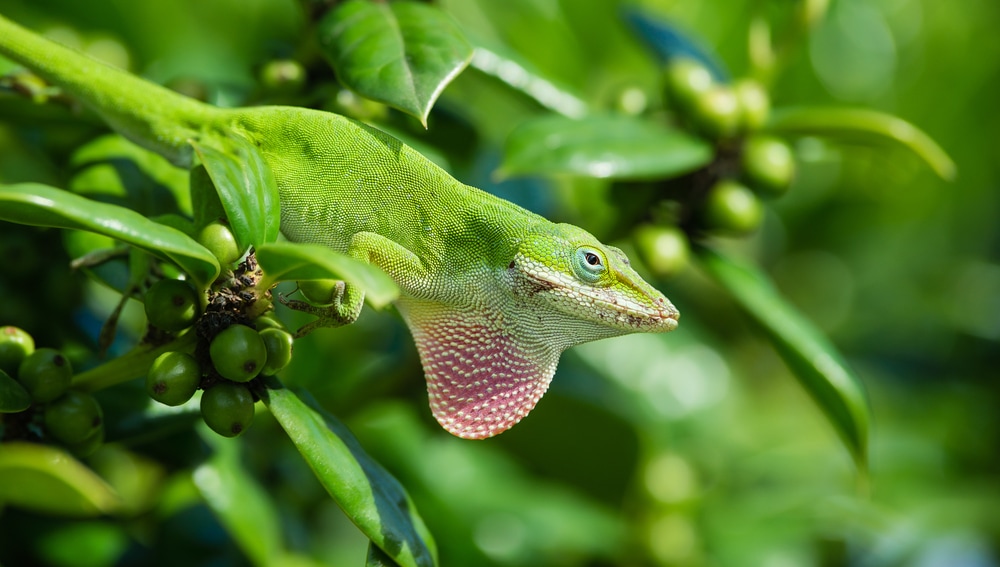
Florida is home to a vast array of wild reptiles, from Florida turtles and snakes to alligators and lizards. The warm, humid climate is perfect across most of the state for cold-blooded creatures to stay active throughout the year. Of particular interest are anoles, lizards that live in trees and have brightly colored neck flaps.
While there are eight known species of anole established in the Sunshine State, only one is native to the region. The rest were introduced through the pet trade, environmental events, or some other event. To better understand the anoles of Florida, it’s best to know exactly what an anole is.
What Is An Anole?
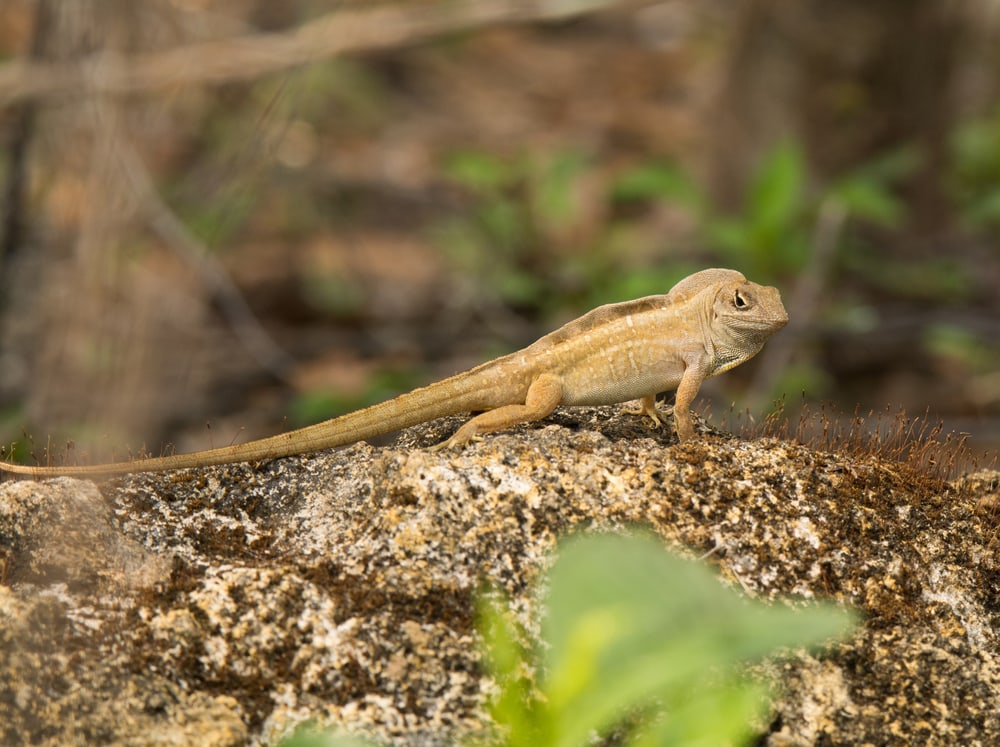
You might just call them lizards or geckos, but anoles are a distinct group of lizards. An anole is defined as any member of the Genus “Anolis.” Members of the family are related to iguanas and are arboreal species. An arboreal species spends most of its life living off the ground in trees or shrubs.
Most species in the family are native to the Caribbean and the Southern United States. Over 200 species of anole are known worldwide.
Anoles have a few distinctive features that help you tell them apart from other species. The biggest of these is a flap on their neck called a dewlap. They’re normally brightly colored flaps of skin that the reptiles can hoist open like a flag during mating rituals or defending their territory.
Another incredible thing anoles can do is to drop their tails. When threatened by a predator, anoles have the ability to detach their tail and escape, growing back another, less functional, tail later on. When dropped, the tail wriggles on the ground to distract the predator.
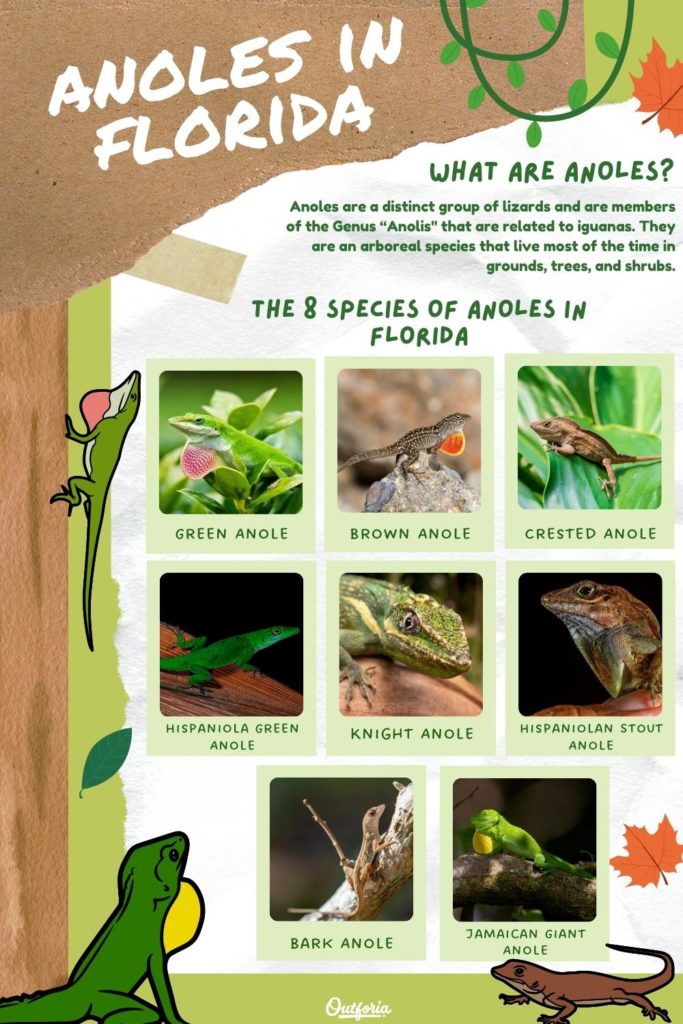
Share this image on your site
<a href="https://outforia.com/anoles-in-florida/"><img style="width:100%;" src="https://outforia.com/wp-content/uploads/2022/05/anoles-in-florida-infographic-2-683x1024.jpg"></a><br>anoles in Florida <a href="https://outforia.com">Outforia</a>You may also like: The 25 Most Amazing Types Of Lizards (Names, Photos And More)
8 Types of Anoles Found in Florida
1. Green Anole
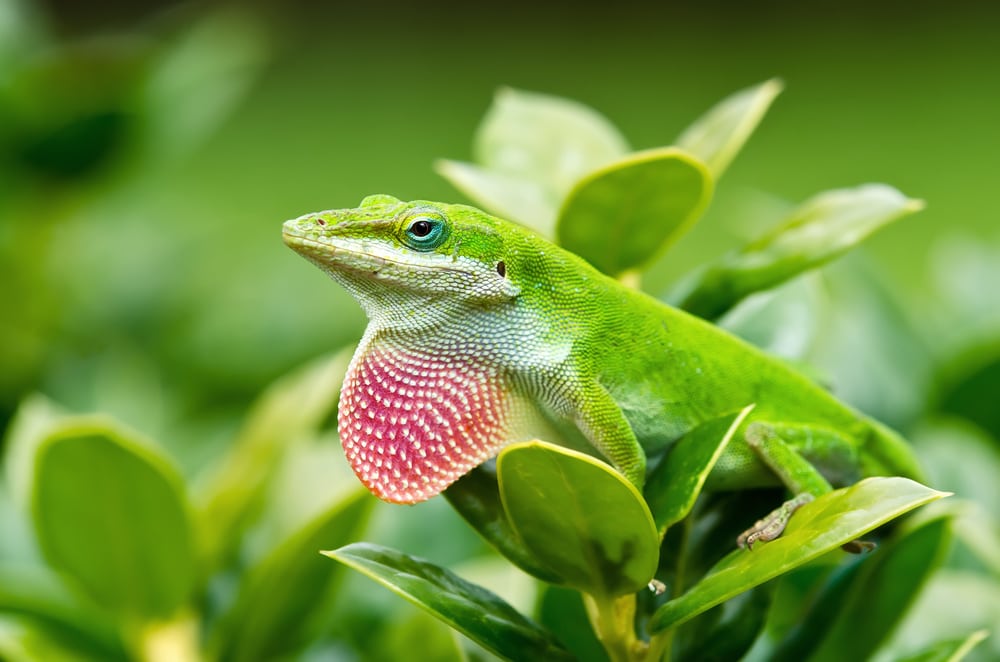
The green anole is the only species of anole that is native to the state of Florida. They tend to range in color from green or mottled green and brown to brown. Green anole’s dewlaps tend to be a shade of pink, but they can also be yellow, red, orange, white, blue, or purple.
On average, adult green anoles are typically between 5-9 inches (12.7-23 cm) in length. They almost always have white bellies and lips. Incredibly territorial, green anoles have been known to attack their own reflection in panes of glass.
Like other anoles, green anoles spend most of their lives in trees. Most often, they can be found near the tops of trees or shrubs, but in urban environments, they’re seen atop fences or on buildings.
Small insects such as crickets, grasshoppers, flies, moths, and spiders make up the bulk of a green anole’s diet. They’ve also been observed to eat small grains, seeds, and smaller reptiles such as skinks.
2. Brown Anole
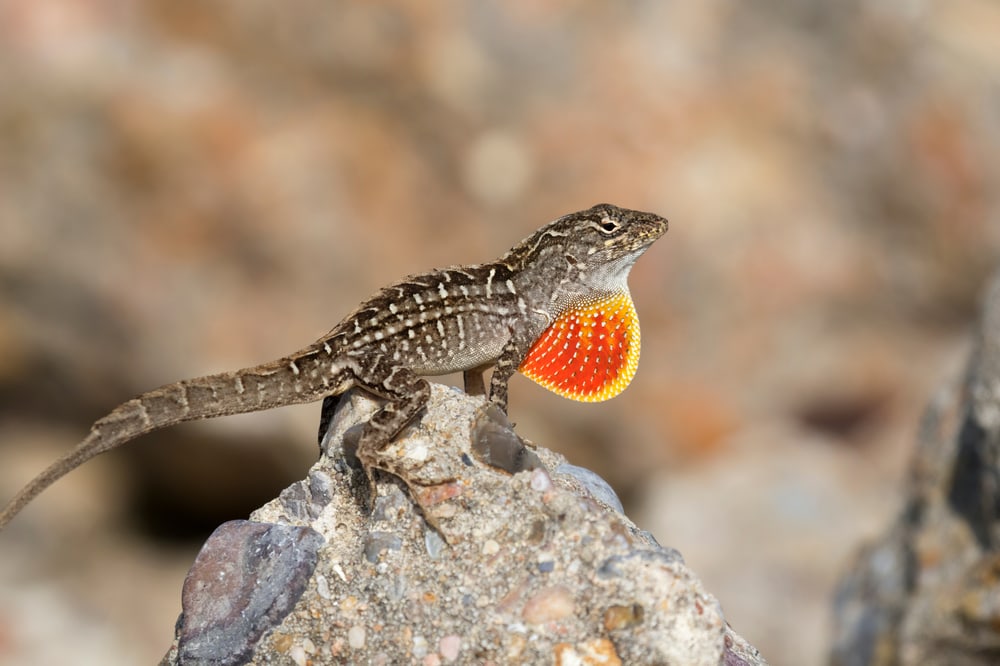
Brown anoles, while invasive, have become the most populous species of anole in Florida. Native to Cuba, these little lizards made their way over in shipments of plants in the 1970s. Since they’re so similar to green anoles in behavior, their introduction has caused green anoles to adapt to a fully arboreal lifestyle to compete.
On average, adult brown anoles reach lengths between 5-8 inches (12.7-20 cm). They’re never green and are almost exclusively brown in coloring, though they may have yellow spots. The dewlap of a brown anole is almost always red or orange with a white border and they’re stockier than green anoles.
While they do climb very well and spend time in trees, brown anoles are commonly found on tree trunks or rocks that they blend in with better than leafy foliage. Open, grassy areas are also popular for them and their population explosion pushed green anoles out of ground habitats almost entirely.
Small arthropods and isopods are popular food sources for brown anoles, including crickets, ants, moths, beetles, and waxworms. They aren’t picky though, going after tiny fish, other reptiles, and even their own molted skin at times.
3. Crested Anole
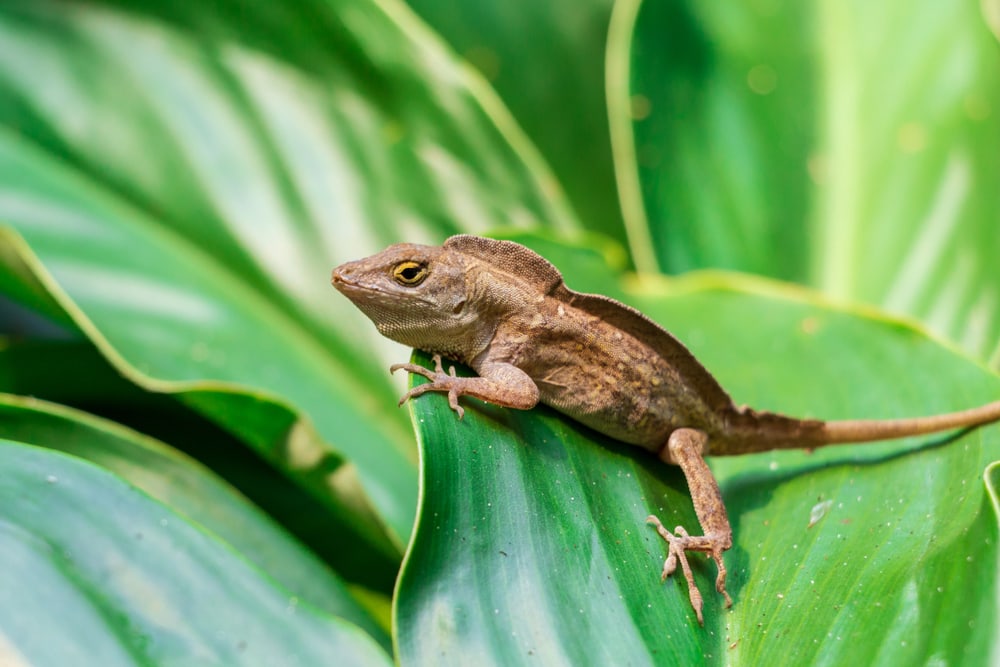
Crested anoles are only found in a few areas of southern Florida and are another invasive species. Native to Puerto Rico and the British Virgin Islands, these stocky and aggressive lizards made their way to the United States in the 1970s, likely through shipments of fruit.
On average, adult crested anoles reach lengths between 4 and 7 inches (10-18 cm). They typically range from brown to grayish-green in color and may have dark rings on their tail. Usually, the dewlap is brown or yellow and can have an orange border. Their most defining feature is the crest that runs the length of their back and tail.
Typically, crested anoles are found on buildings or hiding near the ground on tree trunks. They’re a popular pet species and escaped pets at least partly contributed to their establishment in Florida.
In their native range, crested anoles are known to eat blindsnakes, other anoles, and just about anything that fits in their mouths. In Florida, their diet is roughly the same but may include more insects and invertebrates.
4. Hispaniola Green Anole
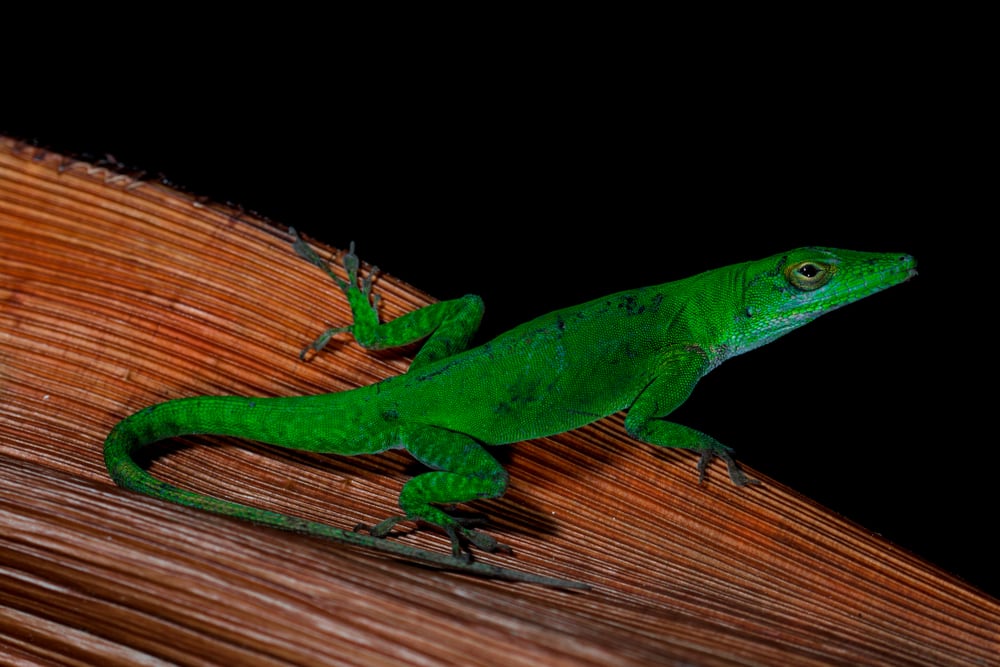
It can be incredibly hard to tell a Hispanola green anole from a regular green anole, so hard in fact that you may need to do a DNA test. Native to Hait, and the Dominican Republic, it’s believed they reached Florida through shipments of palms that contained their eggs.
These guys have a very limited range in South Florida, so if one is seen outside of the range, it’s normally a regular green anole. They tend to be green or brown, with a pale grayish-blue and purple and black dewlap. Adults reach an average length between 5 to 8 ½ inches (12.7 to 21.5 cm).
Trees, shrubs, and outbuildings in southern Florida are the most likely places to spot this anole. In areas where they overlap with green anoles, they interbreed, leading to a hybridized sub-species of the two.
Like the green anole, their diet mostly consists of small insects and invertebrates. They prefer to stay higher up, sitting on perches and waiting for their prey to fly by.
5. Knight Anole
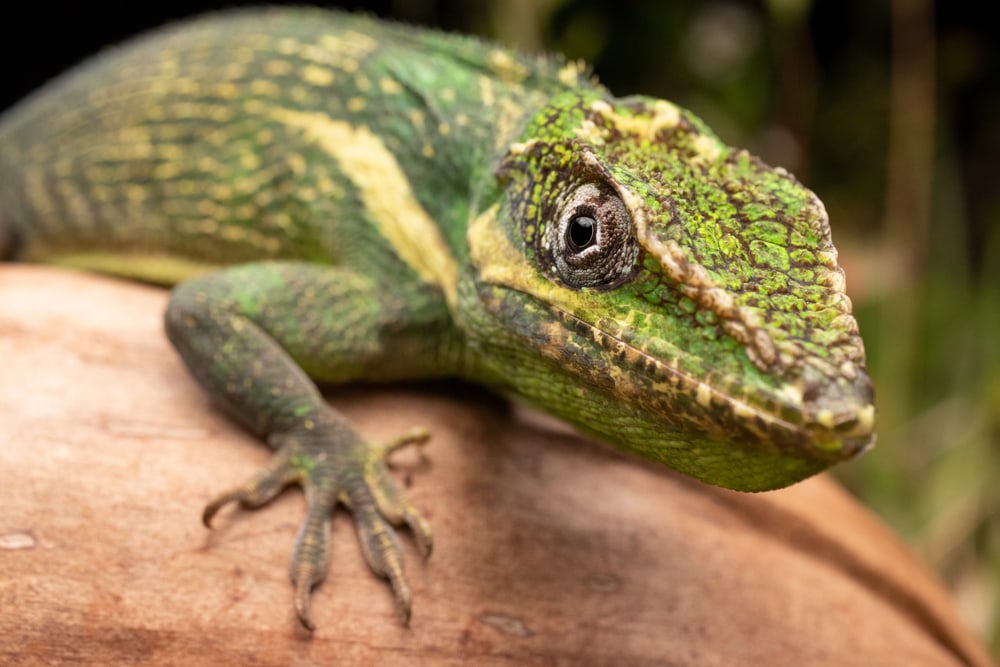
The knight anole is also known as the Cuban giant anole and is the largest known anole species. Typically, they reach lengths between 13 and 20 inches (33 to 51 cm). While all anoles are aggressive, the knight anole is the most fierce, displaying with its large crest and doing pushups when threatened.
Knight anoles have a prominent, ridged indentation on their heads that somewhat resembles a snake. Typically, adults are a bright green but can also change to brown when stressed. Their large dewlap tends to be a shade of pink.
While native to Cuba, the knight anole has established populations in southern Florida around Miami, the Florida Keys, and near the Everglades. They live an entirely arboreal lifestyle, almost never touching the ground.
As juveniles, insects make up most of their diet. Once fully grown, knight anoles eat a varied diet of insects, fruit, small birds, and small reptiles.
6. Hispaniolan Stout Anole
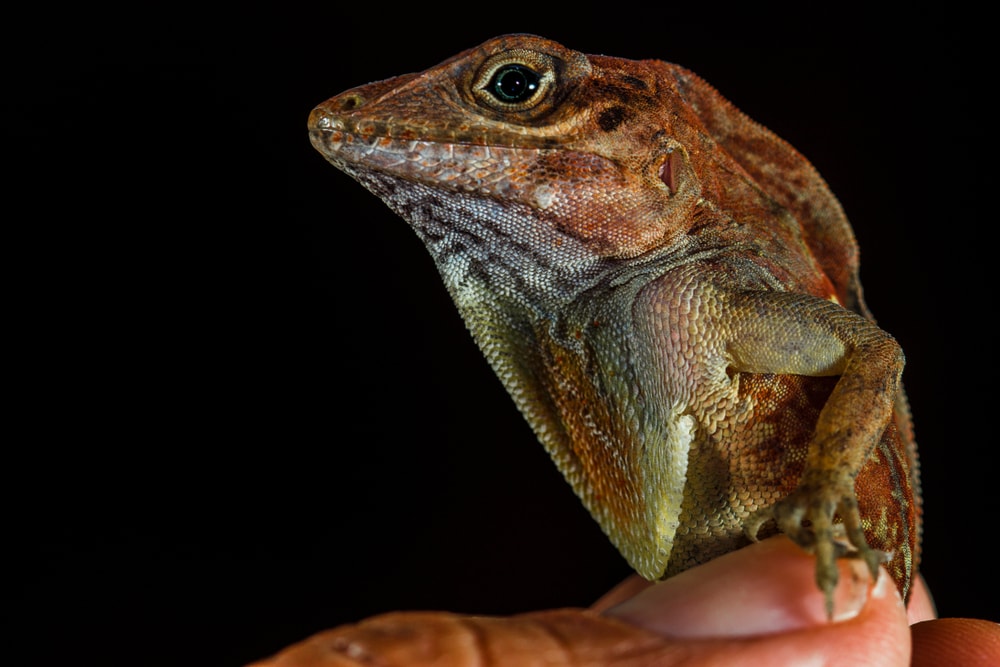
The stout anole is another species that made its way to Florida from the island of Hispanola. Reaching lengths between 7 and 8 inches (18 and 20 cm), they’re also called the large-headed anole due to males having abnormally large heads.
Stout anoles tend to be a light brown or tan color, with darker brown crossbands on the backs of males. The dewlap is a pale yellow and can have an orange center to it.
Specific in Florida to the Miami area, stout anoles have small but stable breeding populations in the United States. Their native range only includes the Tiburon Peninsula of Haiti. Most often you can find stout anoles near the ground on tree trunks or climbing human-made structures.
Small insects, smaller lizards, fruit, and nectar are the staples of a stout anole’s diet. Birds, larger anoles and lizards, and sometimes parasitic flies are all predators for the stout anole.
7. Bark Anole
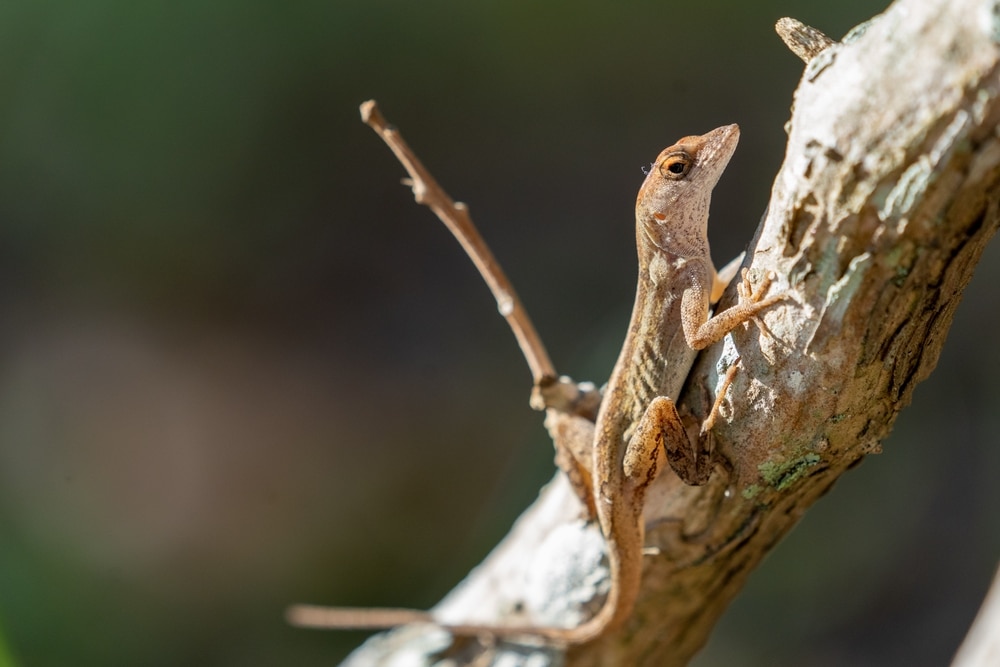
Bark anoles got their name from their unique coloring that helps them blend in on tree trunks. Most will be gray, brown, or green, with light stripes and spots that break up their camouflage. The dewlap is yellow and may also contain some orange colors in it.
Native to the Bahamas and Hispaniola, the bark anole can again be found around the Miami area in Florida. Most adults reach a length between 3 ½ to 5 inches (9 to 12.7 cm).
For the most part, these anoles can be found clinging to the bark of trees where they blend in best. They likely made their way to Florida through combined contributions of the pet trade and hiding in cargo shipments coming from Hispanola.
Most of their diet consists of small prey such as ants, woodlice, and other tiny insects. They’re one of the smallest and least aggressive anole species, preferring to hide than fight when threatened.
8. Jamaican Giant Anole
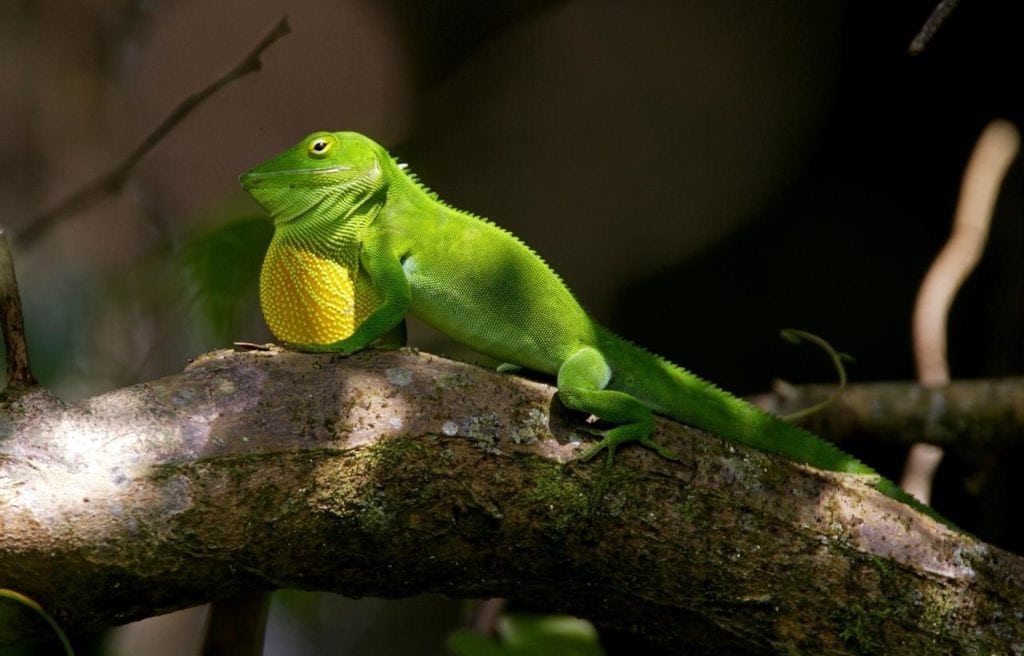
Jamaican giant anoles change color throughout the day cycle, normally a bright green during the day and brown during the night. Their dewlap tends to be yellow and orange for males while being a beige color for females. Adults reach lengths between 5 ½ to 10 ½ inches (14 to 27 cm).
Native to Jamaica, these tree-top-loving lizards can be found in southern areas of Florida. They were able to establish themselves in Florida thanks to being popular in the exotic pet trade. Escaped pets found an excellent home in the southern Florida forests.
The easiest way to identify this anole is the row of spines running the length of their body along their back. Most of their diet consists of insects and small invertebrates. Fruit and smaller anoles can also end up on their menu.
You may also like: 18 Most Common Types Of Lizards In Florida: ID Guide + Photos, And More
Florida and Invasive Species
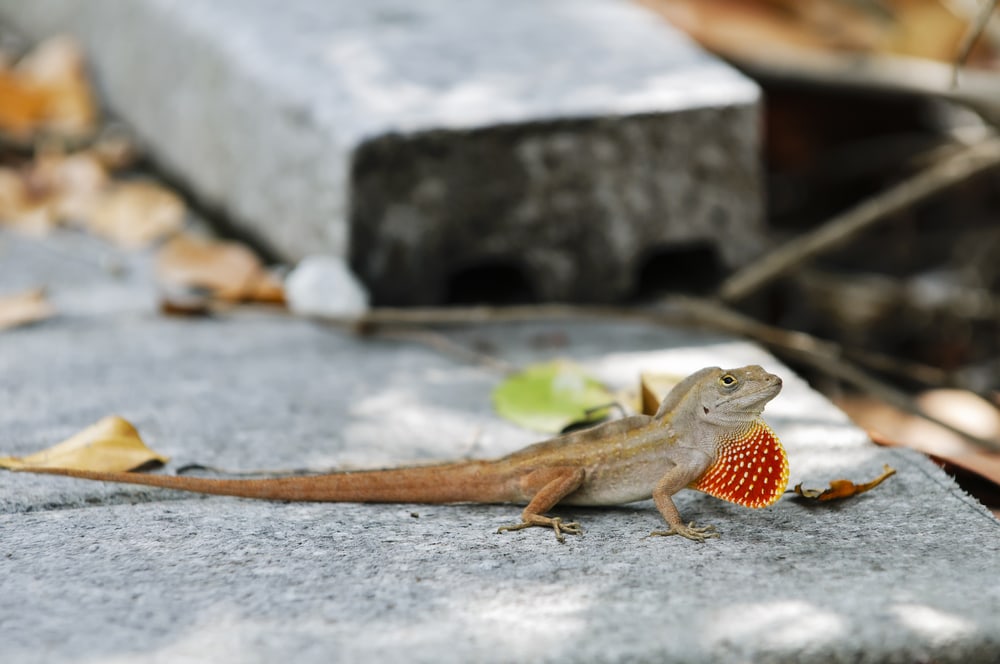
Florida is an easy place for most animals to adapt to. The warm, humid climate is very similar to places like the Caribbean, Central America, South America, and parts of Africa. Once these animals get out, it’s pretty easy for them to survive. They usually have no natural predators and can compete with native wildlife for resources.
When it comes to invasive species, there are some important questions that need to be answered.
What is an Invasive Species?
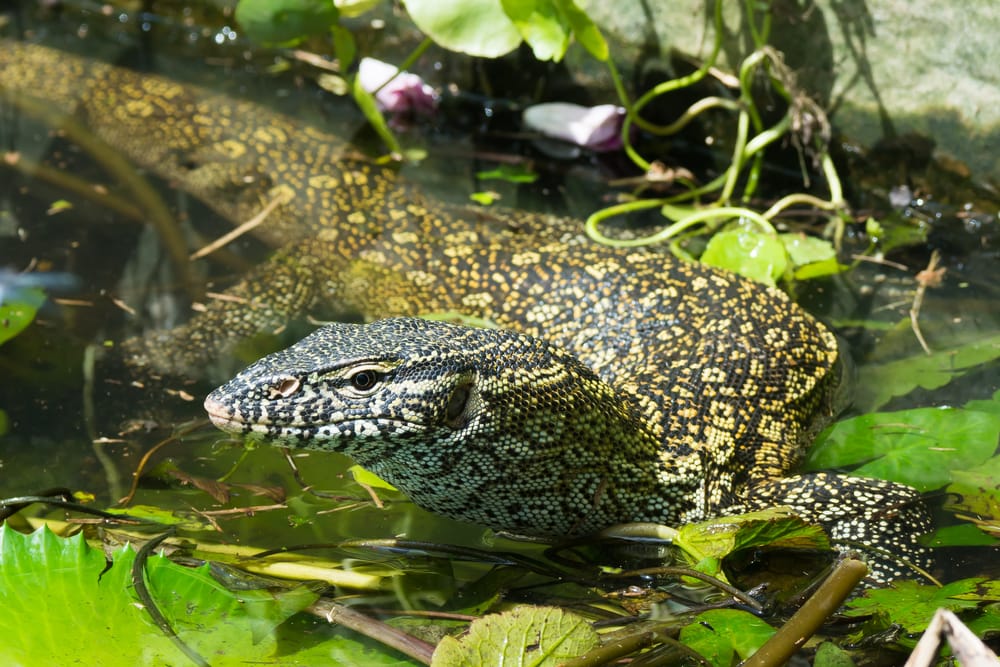
An invasive species is any species of plant or animal that is not native to an environment and causes harm to the ecosystem. Not all introduced animals are considered invasive, though the terms are commonly used interchangeably.
To call a species established, it has to reach a stable population level that can breed and keep its numbers up. Since the climate in Florida is favorable for most animals, the weather is generally not an obstacle for them to overcome.
Ecosystems tend to be very balanced, with predators controlling prey populations and animals adapting to overcome pressure put on by those predators. When a species is introduced to an environment for the first time, it adds pressure without having natural pressure put on it.
As an example, Nile monitors from Africa have made their way to Florida. They have essentially no natural predators here aside from maybe alligators because most animals aren’t used to preying on them. Their love of eggs means they end up invading turtle, alligator, and birds nests to feast. They have little pressure on themselves but put extra pressure on other species. This kind of damage and imbalance is what makes them invasive.
How Do Invasive Species Invade?
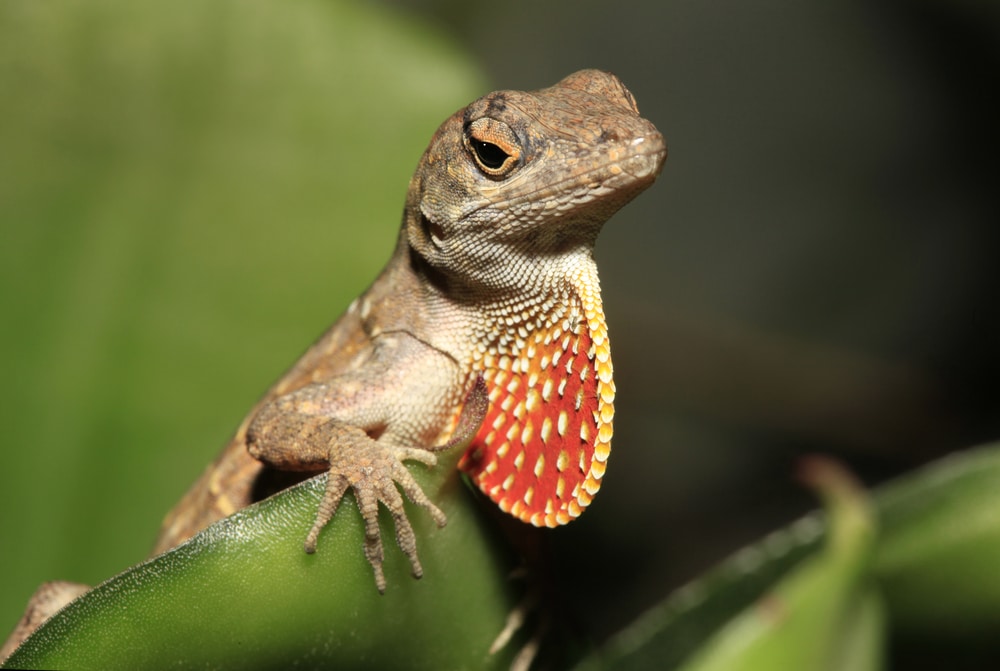
Invasive species tend to end up in new areas in some wacky ways, many of which are the product of human activity. Most of the anoles in the above list made their way to Florida in one of two ways, either being imported as pets and then escaping or hiding out in cargo shipments that came to the state.
The pet trade has resulted in quite a few invasive species establishing themselves in Florida. Pretty and exotic animals like anoles, frogs, toads, snakes and other reptiles can be popular. How they escape from pet owners can vary widely.
Sometimes irresponsible owners simply release them into the wild because they don’t want to care for them. In Florida, hurricanes and other storms can cause property damage that results in animals escaping even the most caring owners. Once in an area that meets their needs, they can become established.
For anoles and some other species, cargo shipments brought them to Florida. Eggs of the species were laid on fruit, cultivated trees, or other goods that got shipped to the states. When the eggs hatched, that began the introduction of the species.

Other factors can also have a hand in introducing a non-native species. Labs use animals like monkeys for testing and those escaped individuals were part of why there are some small wild populations of monkeys in Florida.
Zoos are another importer for animals and like labs, homes, and museums, can be subject to damage from storms and escaped animals.
While uncommon, sometimes species can be introduced through natural events. Eggs or tiny animals can be carried by storms, changes in climate can expand natural ranges, or seemingly random events can lead to a species introduction.
What Invasive Species Are in Florida?
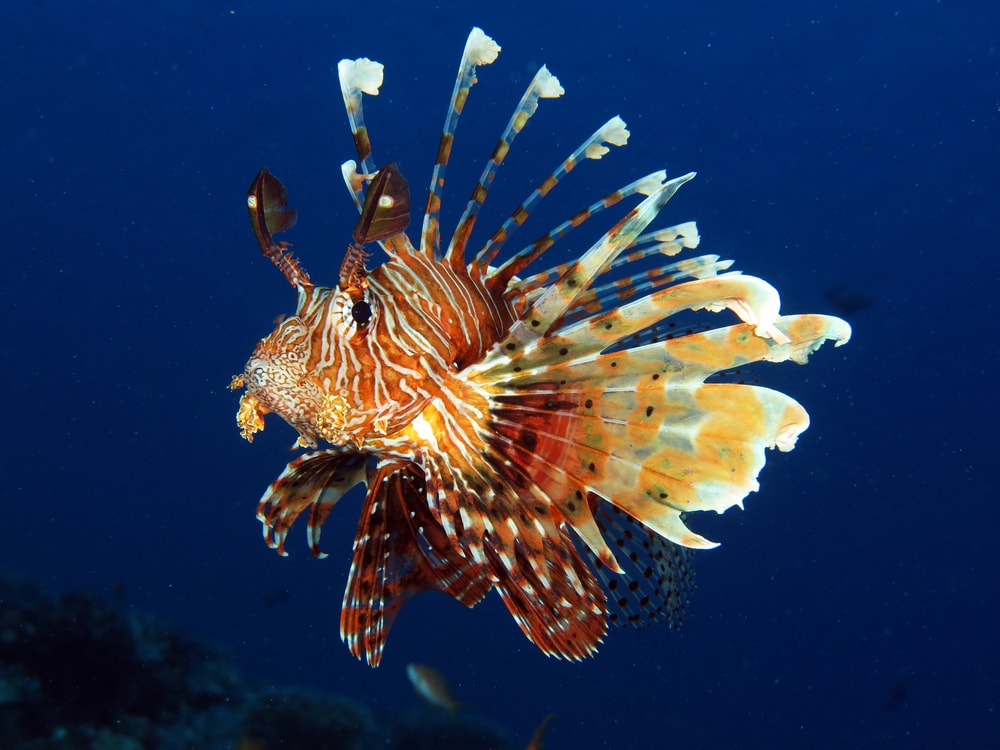
For a full list of non-native species in Florida, you should check out the Florida Fish and Wildlife Commission’s website on non-native species. The list is far too long to go over thoroughly here, so we’ll discuss some of the more interesting species.
Anacondas, pythons, and boa constrictors are all finding homes in the Everglades. Snakes that can grow to nearly twenty feet in length (six meters), they’ve been able to prey on everything from deer to alligators. For now, their range is mostly contained to the Everglades, though the extent of their damage and population increase is unknown.
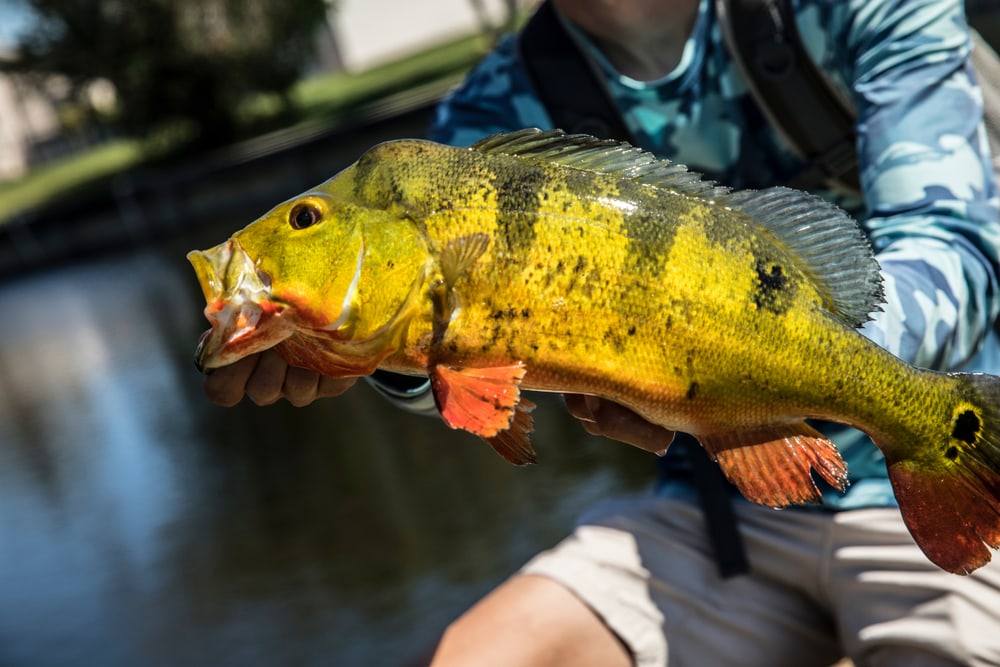
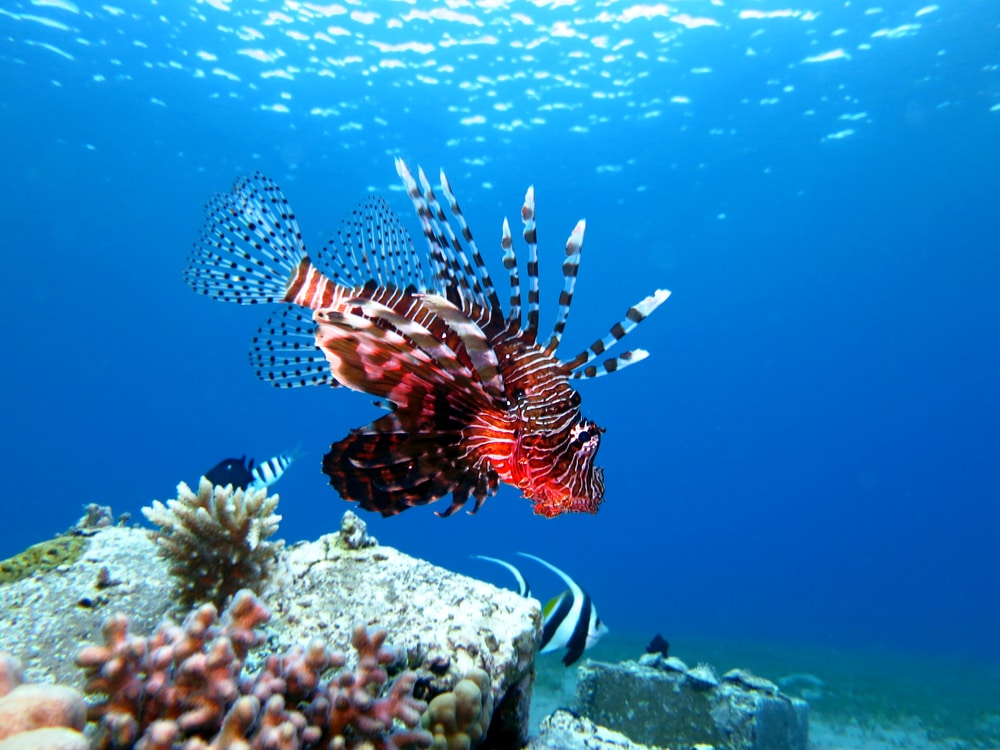
Lionfish are a major issue in the saltwater environments of the Gulf of Mexico. Originally released around Miami, these voracious predators can swallow hundreds of juvenile fish each day. Native to the Pacific Ocean, they have no natural predators here and ran rampant until removal efforts began controlling populations.
Peacock bass is an example of a non-native species that was purposefully introduced. These colorful fish were brought in to control invasive exotic fish populations like tilapia in canals and other bodies of water in southern Florida. So far, this experiment has been a success, seeing as they created a profitable sportfishing industry, controlled pest populations, are confined to the areas they were meant to be put in, and aren’t known to be damaging for native fish.
Lizards such as the Nile monitor, tegus, anoles, iguanas, and chameleons have all adapted to Florida’s environments. Many can add pressure to native species or outcompete them for resources. The brown anole is a great example, as its widespread introduction completely altered the lives of green anoles native to the state.
You may also like:
Discover different species found in Florida here:

Wild Monkeys In Florida | Poisonous Frogs In Florida | Alligators In Texas | Sharks in Florida | Largest Alligator In Florida | Beach Birds Of Florida | Snakes In Florida | Florida Turtles | Owls In Florida | Lizards In Florida | Florida Spiders | Geckos In Florida | Scorpions In Florida | Florida Frogs | Florida Freshwater Fish | Hawks In Florida | Woodpeckers In Florida | Vultures In Florida | Hummingbirds In Florida | Birds Of Florida |









